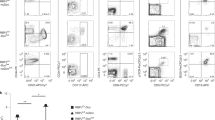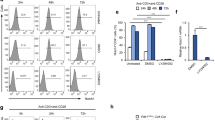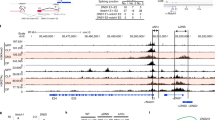Abstract
Deregulated Notch signaling occurs in the majority of human T-ALL. During normal lymphoid development, activation of the Notch signaling pathway poses a T-cell fate on hematopoietic progenitors. However, the transcriptional targets of the Notch pathway are largely unknown. We sought to identify Notch target genes by inducing Notch signaling in human hematopoietic progenitors using two different methods: an intracellular signal through transfection of activated Notch and a Notch-receptor dependent signal by interaction with its ligand Delta1. Gene expression profiles were generated and evaluated with respect to expression profiles of immature thymic subpopulations. We confirmed HES1, NOTCH1 and NRARP as Notch target genes, but other reported Notch targets, including the genes for Deltex1, pre-T-cell receptor α and E2A, were not found to be differentially expressed. Remarkably, no induction of T-cell receptor gene rearrangements or transcription of known T-cell specific genes was found after activation of the Notch pathway. A number of novel Notch target genes, including the transcription factor TCFL5 and the HOXA cluster, were identified and functionally tested. Apparently, Notch signaling is essential to open the T-cell pathway, but does not initiate the T-cell program itself.
This is a preview of subscription content, access via your institution
Access options
Subscribe to this journal
Receive 12 print issues and online access
$259.00 per year
only $21.58 per issue
Buy this article
- Purchase on Springer Link
- Instant access to full article PDF
Prices may be subject to local taxes which are calculated during checkout






Similar content being viewed by others
References
Staal FJ, Weerkamp F, Langerak AW, Hendriks RW, Clevers HC . Transcriptional control of t lymphocyte differentiation. Stem Cells 2001; 19: 165–179.
Weerkamp F, Pike-Overzet K, Staal FJ . T-sing progenitors to commit. Trends Immunol 2006; 27: 125–131.
Artavanis-Tsakonas S, Rand MD, Lake RJ . Notch signaling: cell fate control and signal integration in development. Science 1999; 284: 770–776.
Tamura K, Taniguchi Y, Minoguchi S, Sakai T, Tun T, Furukawa T et al. Physical interaction between a novel domain of the receptor Notch and the transcription factor RBP-J kappa/Su(H). Curr Biol 1995; 5: 1416–1423.
Parreira L, Neves H, Simoes S . Notch and lymphopoiesis: a view from the microenvironment. Semin Immunol 2003; 15: 81–89.
Harman BC, Jenkinson EJ, Anderson G . Entry into the thymic microenvironment triggers Notch activation in the earliest migrant T cell progenitors. J Immunol 2003; 170: 1299–1303.
Dik WA, Pike-Overzet K, Weerkamp F, de Ridder D, de Haas EF, Baert MR et al. New insights on human T cell development by quantitative T cell receptor gene rearrangement studies and gene expression profiling. J Exp Med 2005; 201: 1715–1723.
Weerkamp F, Baert MR, Brugman MH, Dik WA, de Haas EF, Visser TP et al. The human thymus contains multipotent progenitors with T/B-lymphoid, myeloid and erythroid lineage potential. Blood 2006; 107: 3131–3137.
Radtke F, Wilson A, Stark G, Bauer M, van Meerwijk J, MacDonald HR et al. Deficient T cell fate specification in mice with an induced inactivation of Notch1. Immunity 1999; 10: 547–558.
Wilson A, MacDonald HR, Radtke F . Notch 1-deficient common lymphoid precursors adopt a B cell fate in the thymus. J Exp Med 2001; 194: 1003–1012.
Pui JC, Allman D, Xu L, DeRocco S, Karnell FG, Bakkour S et al. Notch1 expression in early lymphopoiesis influences B vs T lineage determination. Immunity 1999; 11: 299–308.
Dorsch M, Zheng G, Yowe D, Rao P, Wang Y, Shen Q et al. Ectopic expression of Delta4 impairs hematopoietic development and leads to lymphoproliferative disease. Blood 2002; 100: 2046–2055.
Jaleco AC, Neves H, Hooijberg E, Gameiro P, Clode N, Haury M et al. Differential effects of Notch ligands Delta-1 and Jagged-1 in human lymphoid differentiation. J Exp Med 2001; 194: 991–1002.
La Motte-Mohs RN, Herer E, Zuniga-Pflucker JC . Induction of T-cell development from human cord blood hematopoietic stem cells by Delta-like 1 in vitro. Blood 2005; 105: 1431–1439.
Lehar SM, Dooley J, Farr AG, Bevan MJ . Notch ligands Delta 1 and Jagged1 transmit distinct signals to T-cell precursors. Blood 2005; 105: 1440–1447.
Schmitt TM, Zuniga-Pflucker JC . Induction of T cell development from hematopoietic progenitor cells by delta-like-1 in vitro. Immunity 2002; 17: 749–756.
Weng AP, Ferrando AA, Lee W, Morris JPt, Silverman LB, Sanchez-Irizarry C et al. Activating mutations of NOTCH1 in human T cell acute lymphoblastic leukemia. Science 2004; 306: 269–271.
Weerkamp F, van Dongen JJ, Staal FJ . Notch and Wnt signaling in T-lymphocyte development and acute lymphoblastic leukemia. Leukemia 2006; 20: 1197–1205.
Iso T, Sartorelli V, Chung G, Shichinohe T, Kedes L, Hamamori Y . HERP, a new primary target of Notch regulated by ligand binding. Mol Cell Biol 2001; 21: 6071–6079.
Jarriault S, Brou C, Logeat F, Schroeter EH, Kopan R, Israel A . Signalling downstream of activated mammalian Notch. Nature 1995; 377: 355–358.
Kawamata S, Du C, Li K, Lavau C . Overexpression of the Notch target genes Hes in vivo induces lymphoid and myeloid alterations. Oncogene 2002; 21: 3855–3863.
Tomita K, Hattori M, Nakamura E, Nakanishi S, Minato N, Kageyama R . The bHLH gene Hes1 is essential for expansion of early T cell precursors. Genes Dev 1999; 13: 1203–1210.
Kaneta M, Osawa M, Sudo K, Nakauchi H, Farr AG, Takahama Y . A role for pref-1 and HES-1 in thymocyte development. J Immunol 2000; 164: 256–264.
Deftos ML, Huang E, Ojala EW, Forbush KA, Bevan MJ . Notch1 signaling promotes the maturation of CD4 and CD8 SP thymocytes. Immunity 2000; 13: 73–84.
Reizis B, Leder P . Direct induction of T lymphocyte-specific gene expression by the mammalian Notch signaling pathway. Genes Dev 2002; 16: 295–300.
Wolfer A, Wilson A, Nemir M, MacDonald HR, Radtke F . Inactivation of Notch1 impairs VDJbeta rearrangement and allows pre-TCR-independent survival of early alpha beta Lineage Thymocytes. Immunity 2002; 16: 869–879.
Hoflinger S, Kesavan K, Fuxa M, Hutter C, Heavey B, Radtke F et al. Analysis of Notch1 function by in vitro T cell differentiation of Pax5 mutant lymphoid progenitors. J Immunol 2004; 173: 3935–3944.
Kimble J, Simpson P . The LIN-12/Notch signaling pathway and its regulation. Annu Rev Cell Dev Biol 1997; 13: 333–361.
Lamar E, Deblandre G, Wettstein D, Gawantka V, Pollet N, Niehrs C et al. Nrarp is a novel intracellular component of the Notch signaling pathway. Genes Dev 2001; 15: 1885–1899.
Deftos ML, He YW, Ojala EW, Bevan MJ . Correlating notch signaling with thymocyte maturation. Immunity 1998; 9: 777–786.
Ronchini C, Capobianco AJ . Induction of cyclin D1 transcription and CDK2 activity by Notch(ic): implication for cell cycle disruption in transformation by Notch(ic). Mol Cell Biol 2001; 21: 5925–5934.
Rangarajan A, Talora C, Okuyama R, Nicolas M, Mammucari C, Oh H et al. Notch signaling is a direct determinant of keratinocyte growth arrest and entry into differentiation. EMBO J 2001; 20: 3427–3436.
Ordentlich P, Lin A, Shen CP, Blaumueller C, Matsuno K, Artavanis-Tsakonas S et al. Notch inhibition of E47 supports the existence of a novel signaling pathway. Mol Cell Biol 1998; 18: 2230–2239.
Carlesso N, Aster JC, Sklar J, Scadden DT . Notch1-induced delay of human hematopoietic progenitor cell differentiation is associated with altered cell cycle kinetics. Blood 1999; 93: 838–848.
Staal FJ, Weerkamp F, Baert MR, van den Burg CM, van Noort M, de Haas EF et al. Wnt target genes identified by DNA microarrays in immature CD34+ thymocytes regulate proliferation and cell adhesion. J Immunol 2004; 172: 1099–1108.
Jeannotte L, Lemieux M, Charron J, Poirier F, Robertson EJ . Specification of axial identity in the mouse: role of the Hoxa-5 (Hox1.3) gene. Genes Dev 1993; 7: 2085–2096.
De Smedt M, Reynvoet K, Kerre T, Taghon T, Verhasselt B, Vandekerckhove B et al. Active form of Notch imposes T cell fate in human progenitor cells. J Immunol 2002; 169: 3021–3029.
de Ridder D, Staal FJ, van Dongen JJ, Reinders MJ . Maximum significance clustering of oligonucleotide microarrays. Bioinformatics 2006; 22: 326–331.
Sambandam A, Maillard I, Zediak VP, Xu L, Gerstein RM, Aster JC et al. Notch signaling controls the generation and differentiation of early T lineage progenitors. Nat Immunol 2005; 6: 663–670.
Schmitt TM, Ciofani M, Petrie HT, Zuniga-Pflucker JC . Maintenance of T cell specification and differentiation requires recurrent notch receptor-ligand interactions. J Exp Med 2004; 200: 469–479.
Hattori N, Kawamoto H, Fujimoto S, Kuno K, Katsura Y . Involvement of transcription factors TCF-1 and GATA-3 in the initiation of the earliest step of T cell development in the thymus. J Exp Med 1996; 184: 1137–1147.
Taghon T, Thys K, De Smedt M, Weerkamp F, Staal FJ, Plum J et al. Homeobox gene expression profile in human hematopoietic multipotent stem cells and T-cell progenitors: implications for human T-cell development. Leukemia 2003; 17: 1157–1163.
Siep M, Sleddens-Linkels E, Mulders S, van Eenennaam H, Wassenaar E, Van Cappellen WA et al. Basic helix-loop-helix transcription factor Tcfl5 interacts with the Calmegin gene promoter in mouse spermatogenesis. Nucleic Acids Res 2004; 32: 6425–6436.
Maruyama O, Nishimori H, Katagiri T, Miki Y, Ueno A, Nakamura Y . Cloning of TCFL5 encoding a novel human basic helix-loop-helix motif protein that is specifically expressed in primary spermatocytes at the pachytene stage. Cytogenet Cell Genet 1998; 82: 41–45.
Sharp LL, Schwarz DA, Bott CM, Marshall CJ, Hedrick SM . The influence of the MAPK pathway on T cell lineage commitment. Immunity 1997; 7: 609–618.
Fischer A, Schumacher N, Maier M, Sendtner M, Gessler M . The Notch target genes Hey1 and Hey2 are required for embryonic vascular development. Genes Dev 2004; 18: 901–911.
Liu ZJ, Shirakawa T, Li Y, Soma A, Oka M, Dotto GP et al. Regulation of Notch1 and Dll4 by vascular endothelial growth factor in arterial endothelial cells: implications for modulating arteriogenesis and angiogenesis. Mol Cell Biol 2003; 23: 14–25.
Limbourg FP, Takeshita K, Radtke F, Bronson RT, Chin MT, Liao JK . Essential role of endothelial Notch1 in angiogenesis. Circulation 2005; 111: 1826–1832.
Cogle CR, Wainman DA, Jorgensen ML, Guthrie SM, Mames RN, Scott EW . Adult human hematopoietic cells provide functional hemangioblast activity. Blood 2004; 103: 133–135.
Lawrence HJ, Helgason CD, Sauvageau G, Fong S, Izon DJ, Humphries RK et al. Mice bearing a targeted interruption of the homeobox gene HOXA9 have defects in myeloid, erythroid, and lymphoid hematopoiesis. Blood 1997; 89: 1922–1930.
Izon DJ, Rozenfeld S, Fong ST, Komuves L, Largman C, Lawrence HJ . Loss of function of the homeobox gene Hoxa-9 perturbs early T-cell development and induces apoptosis in primitive thymocytes. Blood 1998; 92: 383–393.
Taghon T, Stolz F, De Smedt M, Cnockaert M, Verhasselt B, Plum J et al. HOX-A10 regulates hematopoietic lineage commitment: evidence for a monocyte-specific transcription factor. Blood 2002; 99: 1197–1204.
Aubin J, Chailler P, Menard D, Jeannotte L . Loss of Hoxa5 gene function in mice perturbs intestinal maturation. Am J Physiol 1999; 277: C965–C973.
Taghon TN, David ES, Zuniga-Pflucker JC, Rothenberg EV . Delayed, asynchronous, and reversible T-lineage specification induced by Notch/Delta signaling. Genes Dev 2005; 19: 965–978.
Huang EY, Gallegos AM, Richards SM, Lehar SM, Bevan MJ . Surface expression of Notch1 on thymocytes: correlation with the double-negative to double-positive transition. J Immunol 2003; 171: 2296–2304.
Soulier J, Clappier E, Cayuela JM, Regnault A, Garcia-Peydro M, Dombret H et al. HOXA genes are included in genetic and biologic networks defining human acute T-cell leukemia (T-ALL). Blood 2005; 106: 274–286.
Radtke F, Wilson A, Mancini SJ, MacDonald HR . Notch regulation of lymphocyte development and function. Nat Immunol 2004; 5: 247–253.
Ivanova NB, Dimos JT, Schaniel C, Hackney JA, Moore KA, Lemischka IR . A stem cell molecular signature. Science 2002; 298: 601–604.
Haddad R, Guardiola P, Izac B, Thibault C, Radich J, Delezoide AL et al. Molecular characterization of early human T/NK and B-lymphoid progenitor cells in umbilical cord blood. Blood 2004; 104: 3918–3926.
Neves H, Weerkamp F, Gomes AC, Naber BA, Gameiro P, Becker JD et al. Effects of Delta1 and Jagged1 on early human hematopoiesis: correlation with expression of notch signaling-related genes in CD34+ cells. Stem Cells 2006; 24: 1328–1337.
Weerkamp F, Baert MR, Naber BA, Koster EE, de Haas EF, Atkuri KR et al. Wnt signaling in the thymus is regulated by differential expression of intracellular signaling molecules. Proc Natl Acad Sci USA 2006; 103: 3322–3326.
Acknowledgements
S17-GFP and S17-DL cell lines were kindly provided by H Neves (laboratory of Professor L Parreira, Faculdade de Medicina de Lisboa, Portugal). We thank M Baert, T Visser, P Pavljasevic and K Pike-Overzet for assistance with the HoxA5 transplantation experiments and M Comans-Bitter for preparing the figures.
Author information
Authors and Affiliations
Corresponding author
Additional information
Supplementary Information accompanies the paper on the Leukemia website (http://www.nature.com/leu)
Supplementary information
Rights and permissions
About this article
Cite this article
Weerkamp, F., Luis, T., Naber, B. et al. Identification of Notch target genes in uncommitted T-cell progenitors: no direct induction of a T-cell specific gene program. Leukemia 20, 1967–1977 (2006). https://doi.org/10.1038/sj.leu.2404396
Received:
Revised:
Accepted:
Published:
Issue Date:
DOI: https://doi.org/10.1038/sj.leu.2404396
Keywords
This article is cited by
-
Notch blockade overcomes endothelial cell-mediated resistance of FLT3/ITD-positive AML progenitors to AC220 treatment
Leukemia (2021)
-
Haematopoietic stem and progenitor cells from human pluripotent stem cells
Nature (2017)
-
GATA3 induces human T-cell commitment by restraining Notch activity and repressing NK-cell fate
Nature Communications (2016)
-
TNF-alpha and Notch signaling regulates the expression of HOXB4 and GATA3 during early T lymphopoiesis
In Vitro Cellular & Developmental Biology - Animal (2016)
-
The NOTCH signaling pathway in normal and malignant blood cell production
Journal of Cell Communication and Signaling (2015)



